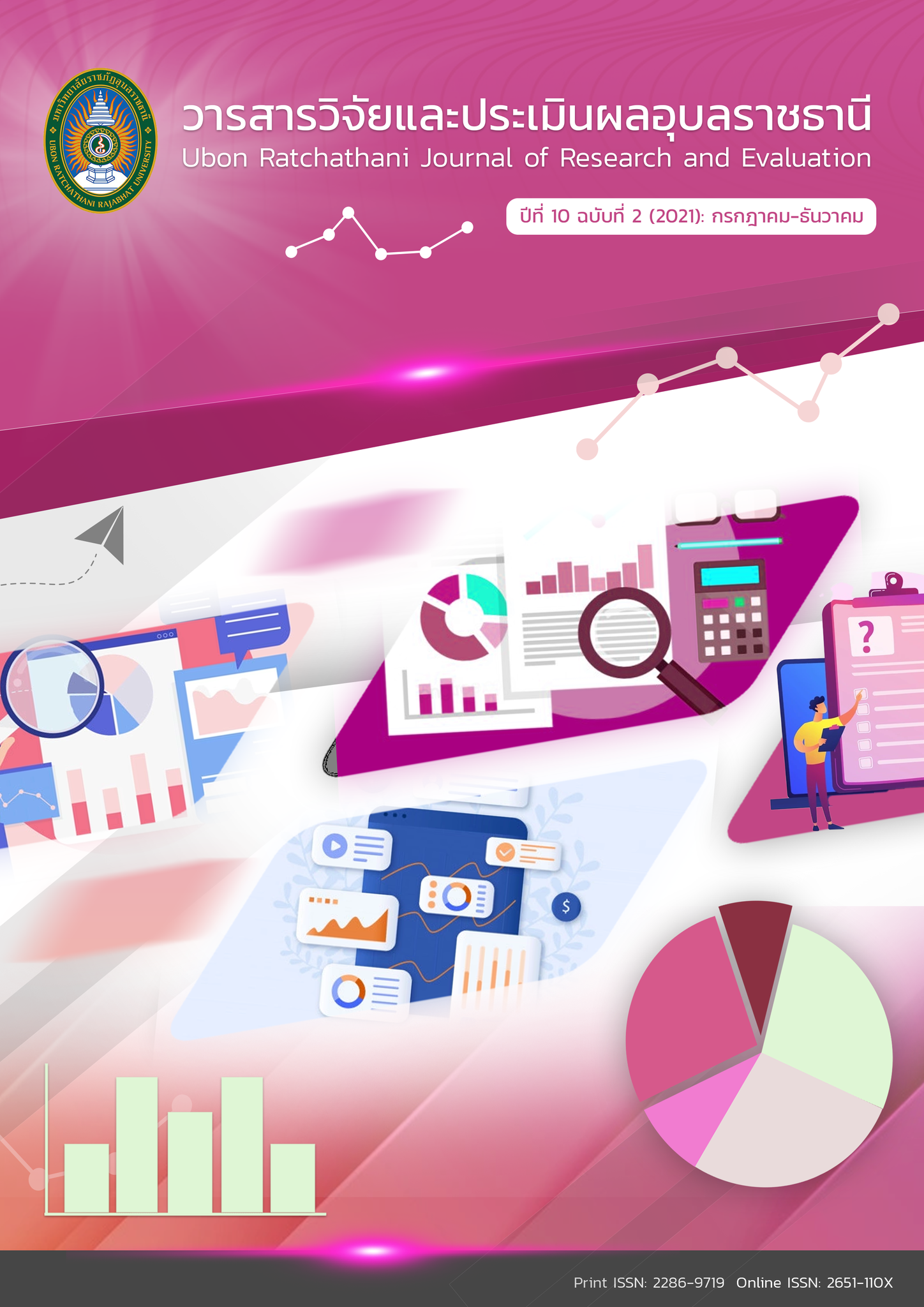The Construction of historical empathy Test of first year undergraduate student Applying Polytomous Item Response Theory
Keywords:
Keywords: The Historical empathy Test, The Polytomous Item Response Theory, The norm.Abstract
The purposes of this research were 1) to construct a historical empathy test for the first-year undergraduate students, 2) to analyze the quality of the historical empathy test for the first-year undergraduate students by applying the polytomous item response theory, and 3) to create a handbook and common criteria for the historical empathy test for the first-year undergraduate students. The samples used in this research were 800 first-year undergraduate students studying in Faculty of Humanities and Social Sciences. The research instrument was a situation test with five- multiple choice questions. The statistics were used to analyze quality based on the original item response theory and the polytomous item response theory.
The research findings were as follows:
- The finding of the quality of the test measured by the analysis of the components of the test was at the Kaiser-Meyer-Olkin of 0.981. the important component component was extracted by rotating the whole component’s core of one component successfully. The examination of the unidimensional basic agreement was found that the historical empathy of the three components had the unique dimension
- The findings of the quality of the test showed that the joint slope parameter was ranging from 1.67 to 2.15 which could be organized as <<<. The analysis of the information function of the test showed that the test gave the highest information when the students had the ability from the moderate level to the high level.
- The handbook of the historical empathy test was used at the highest level. The common criteria of the history empathy test had the raw scores ranging from 36 to 180 and t-score ranging from T46 to T70
References
ปวีณา มะแซ. การพัฒนาแบบวัดทักษะการรู้ททันสื่อในศตวรรษที่ 21 ของนักเรียนชั้นมัธยมศึกษาตอนต้นโดยประยุกต์ ใช้ทฤษฎีการตอบสนองข้อสอบแบบพหุวิภาค. วิทยานิพนธ์ศึกษามหาบัณฑิต สาขาวิชาการวัดและประเมินผลการศึกษา มหาวิทยาลัยสงขลานครินทร์, 2561.
วิลุบล สินธุมาลย์. การรับรู้ประวัติศาสตร์ความสัมพันธ์ไทย-ลาว: ผ่านแบบเรียนประวัติศาสตร์ไทยและลาวชั้นมัธยมศึกษาปีที่ 1-6 (ค.ศ.1975-2009). วิทยานิพนธ์มหาบัณฑิต มหาวิทยาลัยศิลปากร, 2554.
ล้วน สายยศ และอังคณา สายยศ. เทคนิคการวัดผลการเรียนรู้. พิมพ์ครั้งที่ 2. กรุงเทพฯ สุวีริยาสาส์น, 2543.
ศุภณัฐ พานา. การพัฒนารูปแบบการเรียนการสอนประวัติศาสตร์ตามแนวคิดกระบวนการสืบสอบแสวงหาความรู้เป็นกลุ่มร่วมกับแนวคิด Magic If เพื่อส่งเสริมทักษะการคิดทางปะวัติศาสตร์และการรับรู้ความรู้ สึกทางประวัติศาสตร์ของนักเรียนระดับชั้นมัธยมศึกษาตอนปลาย. วิทยานิพนธ์ปริญญาดุษฎีบัณฑิต สาขาวิชาหลักสูตรและการสอน จุฬาลงกรณ์มหาวิทยาลัย, 2560.
ศิริชัย กาญจนวาสี. ทฤษฎีการทดสอบแนวใหม่ (Modern Test Theories). พิมพ์ครั้งที่ 4. กรุงเทพฯ : โรงพิมพ์แห่งจุฬาลงกรณ์มหาวิทยาลัย, 2555.
สุชาดา สกลกิจรุโรจน์. การประยุกต์โมเดลการตอบสนองข้อสอบในการพัฒนามาตรวัดความสุขของคนไทย: การทดสอบแบบปรับเหมาะด้วยคอมพิวเตอร์. วิทยานิพนธ์ปรัชญาดุษฎีบัณฑิต สาขาวิชาการวัดและเทคโนโลยีทางวิทยาการปัญญา วิทยาลัยวิทยาการวิจัยและวิทยาการปัญญา มหาวิทยาลัยบูรพา, 2558.
สุภมาส อังศุโชติ สมถวิล วิจิตรวรรณา และรัชนีกูล ภิญโญภานุวัฒน์. สถิติวิเคราะห์สำหรับการวิจัยทางสังคมศาสตร์และพฤติกรรมศาสตร์: เทคนิคการใช้โปรแกรม LISREL. กรุงเทพฯ : มิสชั่น มีเดีย, 2551.
สุเนตร ชุตินธรานนท์. ชาตินิยมในแบบเรียนไทย. พิมพ์ครั้งที่ 2. กรุงเทพฯ: มิติชน, 2557.
สุวิมล ติรกานันท์. การวิเคราะห์ตัวแปรพหุในงานวิจัยทางสังคมศาสตร์. กรุงเทพฯ: โรงพิมพ์แห่งจุฬาลงกรณ์มหาวิทยาลัย, 2555.
Brooks, S. “Historical Empathy as Perspective Recognition and Care in One Secondary Social Studies Classroom,” Theory & Research in Social Education. 39(2): 166-202.
Hair, J. F., Sarstedt, M., Partial least squares structural equation modeling (PLS-SEM) An emerging tool in business research. European Business Review, 26(2), 106-121, 2014.
Davison, M. “It is Really Hard Being in Their Shoes” Developing Historical Empathy in Secondary School Students. Doctocal Dissertation submitted in partial fulfilment of the requirements for the degree of doctor of education in the Faculty of Education, The University of Auckland, 2012.
Published
How to Cite
Issue
Section
License
1. บทความที่ตีพิมพ์ในวารสารนี้ได้มีการตรวจสอบการลอกเลียนงานวรรณกรรมแล้ว ไม่เกินร้อยละ 25
2. บทความที่ตีพิมพ์ในวารสารนี้เป็นข้อคิดเห็น ข้อค้นพบของผู้เขียนบทความ โดยผู้เขียนบทความต้องเป็นผู้รับผิดชอบต่อผลทางกฎหมายใด ๆ ที่อาจเกิดขึ้นจากบทความนั้น ๆ
3. บทความ ข้อมูล เนื้อหา รูปภาพ ฯลฯ ที่ได้รับการตีพิมพ์ในวารสารวิจัยและประเมินผลอุบลราชธานี ถือเป็นลิขสิทธิ์ของวารสารวิจัยและประเมินผลอุบลราชธานี หากบุคคลหรือหน่วยงานใดต้องการนำทั้งหมดไปเผยแพร่ต่อหรือเพื่อกระทำการใดๆ จะต้องได้รับอนุญาตเป็นลายลักษณ์อักษรจากวารสารวิจัยและประเมินผลอุบลราชธานีก่อนเท่านั้น และจะต้องมีการอ้างอิงวารสารวิจัยและประเมินผลอุบลราชธานี ฉบับนั้น ๆ ด้วย






